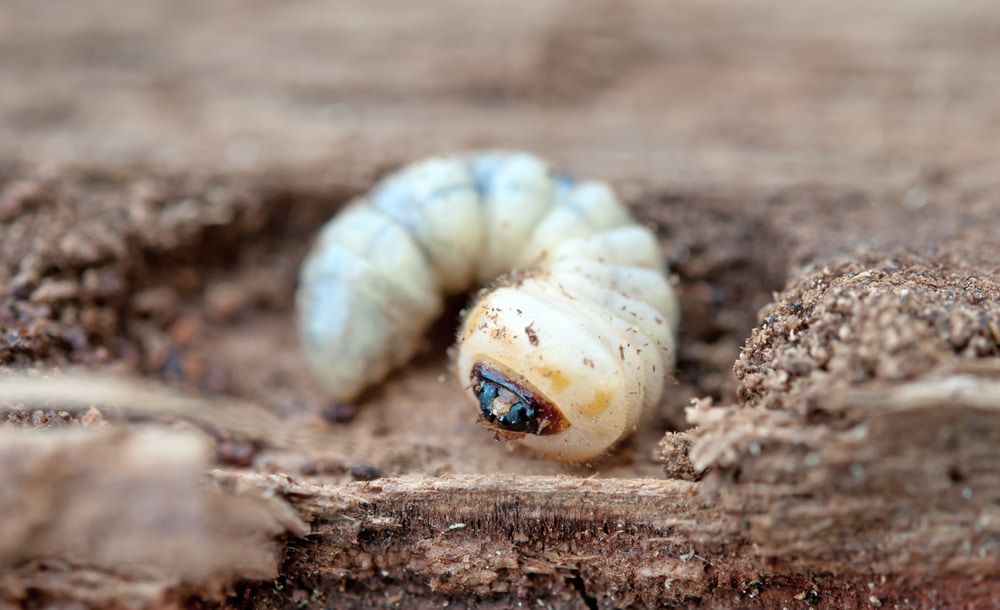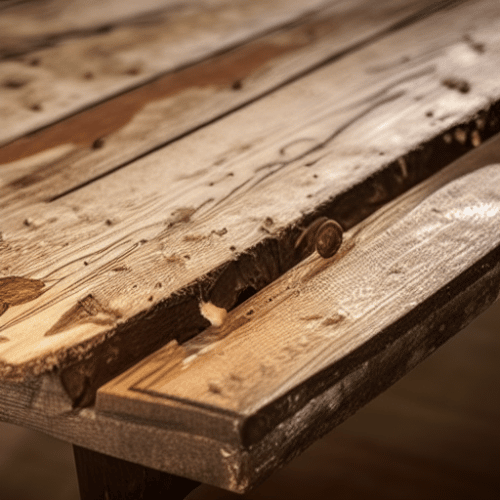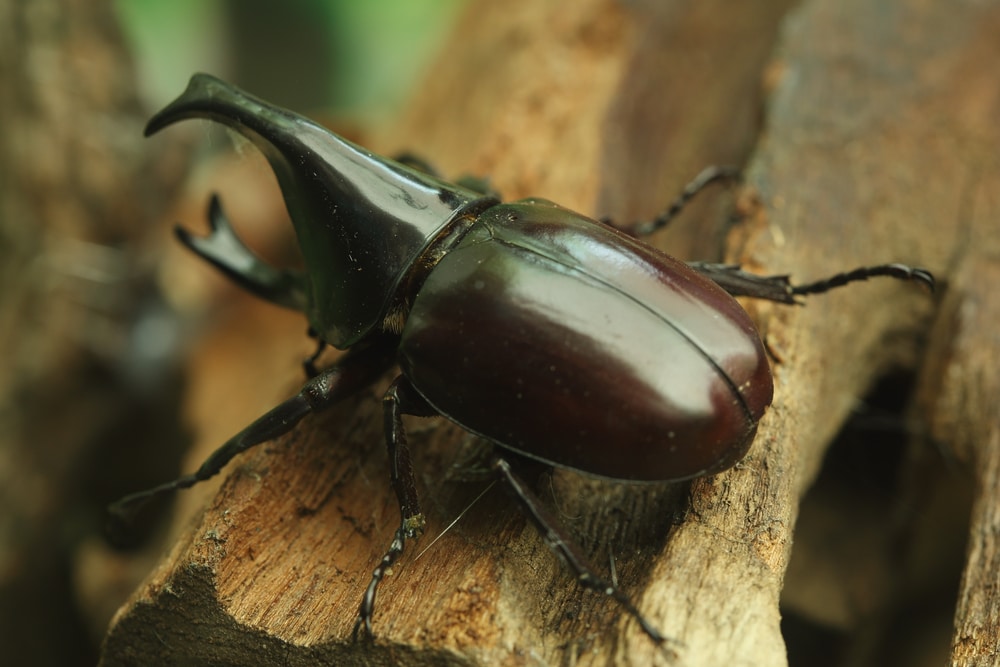Woodworms can be found everywhere, from gardens to houses. You can identify woodworm by looking for small holes in the surface of your timber and sawdust trails.
Most homeowners and inexperienced gardeners are unsure of how to handle this issue. Don’t worry because, in this post, we’ll show you how to treat woodworm infestations using chemical and natural methods.
We’ll also share tips on preventing these pesky creatures from invading your garden in the first place. So read on for all the information you need!
What Are Woodworms, and What Do They Look Like?

Since they don’t know what they’re dealing with or are unaware of the indications of an infestation, people often struggle to get rid of woodworm. As a result, they can make the problem worse or even cause damage to their property.
Woodworms are the larvae of different types of beetles. Found in gardens and houses all over the UK, some of the most woodboring beetles include the following:
Death Watch Beetle
The Death Watch Beetle is characterised by its telltale ticking noise produced by the male tapping his head on the walls of your house.
Death Watch beetles are generally around 15mm in size and can be light brown. These woodboring insects prefer hardwoods such as ash, oak, chestnut and elm.
Powder Post Beetle
Although it has much longer antennae, the Powder Post beetle looks like an ant. The larvae of these woodboring beetles burrow their way through timber after forcing their way through the surface with exit holes resembling sawdust trails.
This type of woodworm presents a risk to public health because it can cause an allergic reaction and can potentially carry diseases such as Weil’s disease.
House Longhorn Beetle

These beetles are characterised by their black and yellow stripes. The adult beetles lay their eggs on damp surfaces, where the larvae hatch and then move onto harder wood once they mature.
The larvae bore tunnels into the wood and continue to eat away at the timber, depositing sawdust as they go. House Longhorn beetle infestations can cause severe structural damage.
Common Furniture Beetle
The Common Furniture Beetle is responsible for most of the woodworm beetle problems that people deal with.
The larvae bore tunnels into softwood timber, such as pine and oak, used in furniture making. Common furniture larvae also feed on hardwood timbers such as elm and sycamore.
Woodworm Life Cycle
A woodworm’s life cycle starts when it lays its eggs in timber, and the larvae hatch from those eggs.
The larvae are small, whitish-yellow insects and feed on the surface of the wood until they have finished growing. The larval stage can take one to three years.
Then, once they have pupated, the adult beetles emerge and lay eggs, starting the whole life cycle again. This process continues until the woodworm infestation is dealt with properly.
What Are the Signs of a Woodworm Infestation?

There are several signs to look out for if you think that you might be dealing with a woodboring insect attack:
- Small round holes in the surface of your wood, usually in a floor or on furniture
- Thin trails of sawdust across the surface of your timber
- Blue stains across the surface of the wood caused by woodworm larvae burrowing through it
If you have any of the signs mentioned above, then there is a good chance you have an infestation of woodworm.
But how can you be sure? Well, if your house has been built with wooden beams or planks, then it’s likely to be affected at some point.
What Damage Can Woodworms Do?
The larvae of woodworms can cause real damage to the surface of your timber. They eat away at the wood and weaken it until it can’t support itself. That means that floors or furniture can collapse, and beams will degrade quickly.
Woodworms can be a severe problem and can cause irreversible structural damage to your property and belongings if left untreated. But with the proper knowledge and expertise, you’ll be able to identify and deal with active woodworm problems – so that it doesn’t turn into something much worse.
How Do You Get Rid of Woodworms?
Woodworms can be killed by regular beetle sprays, available from DIY stores and supermarkets.
These sprays work because woodworm breathes through holes in the surface of the timber. So if you get one of these sprays on their breathing holes, then they quickly suffocate and die.
However, there are other types of woodworm treatment available too. For example, you could try a non-chemical treatment such as special borax powders. This type of salt works by creating an environment around the beetle larvae where they can’t survive, so they all die within 48 hours.
You can also use vinegar spray as a woodworm treatment to draw the larvae from the exit holes.
How to Treat Woodworm Infestations: A Step-by-Step Guide
Woodworms can be pretty persistent. If an infestation is left untreated, then the problem will come back. Below are our step-by-step instructions on how to get rid of these woodboring insects:
Step 1: Determine if You Have an Infestation
If you want to get rid of a woodworm infestation, the first step to take is to identify the telltale signs the woodworms leave behind. These are tiny holes in the surface of your wood, usually on the floor or on your old furniture. These are usually less than 5mm wide.
Step 2: Clear Out the Affected Areas
Check your doors and window frames since they’re most susceptible to woodworm. Check any furniture in your house, including under tables or behind cupboards. Also, make sure that you check inside fireplaces.
Step 3: Use Your Woodworm Treatment of Choice
After you’ve cleared out the affected areas, you can treat the infestation using your method of choice. Woodworm treatments include:
Pesticides
Many people use chemical pesticides such as DDT (Dichloro Diphenyl Trichloroethane) when treating woodworm beetles in the UK. However, this type of product is harmful to humans and animals and can cause headaches and nausea in some individuals.
You can also use a woodworm treatment spray that contains Permethrin. This effectively kills the larvae, but it can be toxic as well. Hence, make sure you let the spray fully dry before using the treated furniture or area again.
Borax
If you don’t want to use insecticides, there are many non-chemical ways of treating woodworm.
For example, you could try a non-chemical treatment such as special borax powders. This type of salt works by creating an environment around the larvae where they can’t survive, so they all die within 48 hours.
To use this method, you need to mix 50 mg of the powder with 1 litre of water. Then, apply two coats using a brush or a sponge. Let the first coating dry completely before applying the second one.
Vinegar
Treating woodworm with vinegar is also possible. Combine equal parts of white vinegar and water in a spray bottle. Spray onto the holes in your furniture where you have seen marks left by the beetles.
This will irritate the larvae and will draw them out of the holes. However, be aware that this woodworm spray may damage your furniture’s finish.
Fungicides
Some fungicides also eradicate woodworms. These products work by killing woodworm larvae in the tunnels. They will also help prevent woodworm reinfestation.
These products are water-based, so it seeps into the timber, reaching into the timber chambers, which are inaccessible to other types of treatment. It’s important to remember that these do not kill adult beetles.
However, you should be careful when using chemicals to get rid of woodworms. Always read package labels carefully to make sure you are using the correct product, and only use products in accordance with what is stated.
You should also always take safety precautions when handling chemicals, especially if you have pets or children in your home.
Step 4: Preventing Future Wood infestations
Woodworm treatment also includes preventing future infestations. Ensure you eliminate any woodworm sources from your and prevent adult woodboring beetles from entering your home.
Woodworm Prevention Tips

When getting rid of an active woodworm infestation, it is essential to remember that the pest will try to return after you’ve treated them. For this reason, it’s advisable that you prevent an infestation from happening in the first place by following these tips:
- Identify the woodworm problem as fast as you can. That means inspecting structural timbers, wooden beams, furniture, window sills and outdoor structures. Remember, it only takes one adult beetle to start a pest problem.
- Keep wooden surfaces away from heat sources such as fireplaces and central heating radiators. Keep humidity levels below 20%
- Prevent any wood from getting damp in your building. If possible, use a dehumidifier to keep humidity levels down in the affected area.
- Inspect antique furniture for any signs of woodworm before you purchase them.
- Fix windows and doors to ensure they are airtight to prevent beetles from entering.
- Keep exterior timbers covered without letting them get damp. Damp wood is the most susceptible to woodworm.
- Keep firewood away from your main house to reduce the risk of beetles entering.
- Cover woodpiles with tarpaulin sheets or mesh to prevent woodboring beetles from moving around.
- If possible, discard any infected wood or rotting wooden pieces you find.
- Keep all food items sealed in airtight containers to keep away any adult beetles that might be attracted to their smell of them.
- Keep your property clean. This means removing any excess debris from the outside of your property, no matter how small it may be. Ensure that all gutters are clean and free of leaves or other organic materials that might provide food for woodworm larvae.
- Consult woodworm treatment specialists if you still think you have a problem after the initial treatment. They will perform a woodworm survey to determine any remaining infestations before implementing professional treatment such as woodworm fumigation.
Many people don’t realise the importance of woodworm prevention. Woodworms can cause a lot of damage to your property, so it’s vital to take the necessary steps to prevent them from infesting your home.
Frequently Asked Questions About Woodworm Treatments
Can I Treat Woodworm Myself?
You can treat it yourself, but if the damage is severe or you are concerned about safety when dealing with chemicals, it’s best to hire professional pest control teams.
What Is the Best Woodworm Treatment?
It depends upon the severity of the woodworm damage, but many use pesticides.
How Do I Stop Woodworms From Coming Into My Home?

To prevent your home from being infested with woodworms, avoid having damp timbers around your house, as these are the most likely spots for beetles to breed.
How Long Does it Take to Get Rid of Woodworms?
It depends upon the extent of the damage and safety factors. Usually, 2 or 3 treatments are needed.
Preventing and Treating Woodworm Infestations
Woodworm infestation can be a major problem, especially if it goes untreated. Fortunately, you now know how to treat woodworm infestations and prevent future ones from occurring. Remember, prevention is critical when dealing with these pests.
If you found this article helpful and informative, please feel free to pass this information on to friends and family. For more home maintenance tips, check out the other articles in this blog.







